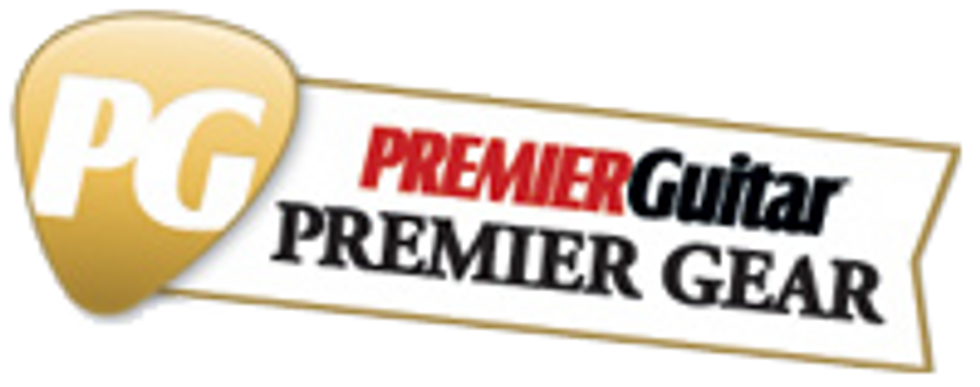Kevin Brubaker has been building dynamic basses and guitars for over 20 years. Brubaker’s diverse bass lineup ranges from the budget-friendly Brute line to the single-cut beauties of the KXB series. The JXB Standard resides between those extremes. It’s Brubaker’s take on the classic J-style formula, fusing traditional looks and modern construction.
More Neo Than Leo
It may seem easy to pass off the JXB Standard as another J-style bass from Clone Mountain, but a closer look reveals savvy improvements on the original design.
A high-gloss finish, highlighting the bass’s deep grain patterns and excellent book matching, protects the JXB Standard’s two-piece alder body. The classic J-style contours are there, but Brubaker adds unique cutaways on the back of the body and the lower horn that provide uninhibited access to the upper fretboard. The quilted-maple pickguard and control plate are wonderfully decorative alternatives to the conventional plastic and chrome components.
The one-piece maple neck is sprayed with a smooth satin finish. Brubaker bolts the neck deeply into the body, a technique he calls “bolt-thru.” This provides more contact between the neck and body woods, intended to increase the transfer of vibrations throughout the instrument. Brubaker keeps the fretboard free of position dots, allowing the eyes to better appreciate the rosewood fretboard’s red hues and grain pattern. Don’t fret: There are pearloid side markers for those “lost” moments.
The solidly constructed neck and body are an ideal foundation for the JXB’s electronics and hardware. The battery compartment and 4-knob configuration might imply active electronics, but a peek into the control cavity reveals a passive system. (Players can opt for an active electronics mod, taking advantage of the battery slot and pre-routed body.)
The controls consist of master volume, neck-pickup volume, bridge-pickup volume, master tone, and a vintage/modern switch. Brubaker chose a pair of Aguilar AG 4J-HC hum-cancelling pickups for J-style tone with silent operation. Supporting the strings are Hipshot Ultralight tuners and a Babicz Full Contact bridge.
Ratings
Pros:
Clean and versatile tones. Excellent ergonomics.
Cons:
Pricey. Might not win over pre-CBS Fender fans.
Tones:
Playability:
Build:
Value:
Street:
$2,499 street
Company
brubakerguitars.com
Comfy, Clean, and Cool
It was immediately clear that this would be a comfortable bass. It weighs a manageable 8.6 pounds and balances perfectly, holding its position at every playing angle. I experienced zero back pain or shoulder fatigue after a four-hour gig. In fact, my playing posture actually seemed to improve every time I strapped on the bass.
I auditioned the JXB though an Epifani UL 501 amp with an Epifani 2x12 cabinet. I positioned all the JXB’s knobs to their fullest and encountered punchy lows, midrange growl, and a top end with a deceptively active-like edge. The clean, articulate tones are reminiscent of ’70s-era Fender Jazz basses, but with a dash of modern zing. They’re perfect for aggressive thumb work and thick, cutting pops for funk and modern gospel music. On an R&B horn-band gig, fingerstyle passages fit right in the mix. Digging into the strings added crunch and presence, maintaining an authoritative voice within the ensemble.
Players who swear by their bridge pickups will dig the JXB’s pointed midrange bark. A slight tone-knob cut warmed up the snarling soloed pickup, making it ideal for clean 16th-note passages. The neck pickup also has plenty to offer. While it’s not often soloed on J-style basses, its hum-canceling capabilities provide additional tonal flexibility without pesky 60-cycle hum. In this mode, slap sounds have a thick, old-school vibe, while fingerstyle lines come close to copping Motown and Stax sounds. I placed a piece of acoustic foam by the bridge for kicks, and while it didn’t convey a spot-on P-style tone, it provided a taste of Jamerson’s classic timbre. Depending on your technique, the JXB can be quite the tonal chameleon.
The Verdict The JXB Standard delivers an ideal blend of comfort and versatility. It takes some of the most beloved traits of the Fender Jazz Bass and improves on them with contemporary flair. Brubaker’s latest creation is an excellent option for those who prefer to take one bass to a gig. The price tag might raise a few eyebrows, but such a highly playable, expertly crafted U.S.-made instrument justifies the investment. If you haven’t found your match among other J-style offerings, you owe it to yourself to take a look at the Brubaker JXB Standard.





























